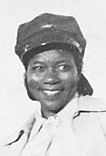 Excerpted from the book Hear Me Roar: Women, Motorcycles and the Rapture of the Road, Copyright © 1993, 1996, 2000, 2002 by Ann Ferrar. All rights to this content are reserved by the author. Photos from the collection of Ann Ferrar. All rights reserved.
Excerpted from the book Hear Me Roar: Women, Motorcycles and the Rapture of the Road, Copyright © 1993, 1996, 2000, 2002 by Ann Ferrar. All rights to this content are reserved by the author. Photos from the collection of Ann Ferrar. All rights reserved.
The life of African-American motorcycling pioneer Bessie Stringfield (1911-1993) seems like the stuff of which legends are made. When the AMA opened the Motorcycle Heritage Museum in 1990, Bessie appeared in the inaugural exhibit on Women in Motorcycling. A decade later, the AMA began giving the Bessie Stringfield Award to women who are leaders in motorcycling. And in 2002, Bessie was inducted posthumously into the Motorcycle Hall of Fame.
In the 1930s and 1940s, Bessie took eight long-distance, solo rides across the United States. The fact that she was a woman of color did not stop Bessie from achieving her goals and setting herself apart. She even rode through the Deep South in the era when racial prejudice was a threat to her safety. She downplayed her courage.
During recording of her oral history for Ann Ferrar’s primary-sourced book Hear Me Roar: Women, Motorcycles and the Rapture of the Road, Bessie revealed to the author how she drew courage from her faith in Jesus Christ, whom she called the “Man Upstairs.”
“When I was in high school I wanted a motorcycle, and I got one," she said. Her first bike was a 1928 Indian Scout. With no prior knowledge of how to operate the machine, Bessie proved to be a natural. But she insisted that the Man Upstairs gave her the skills.
Soon, Bessie switched to the first of 27 Harleys that she owned in her lifetime. She tossed a penny over a map and rode to wherever it landed, eventually covering the lower 48 states. Sometimes she did trick riding demonstrations in front of audiences. But it was her faith that got her through many nights.
During the Hear Me Roar recordings, Bessie said, "If you had black skin you couldn’t get a place to stay. I knew the Lord would take care of me and He did. If I found black folks, I’d stay with them. If not, I’d sleep at filling stations on my motorcycle."
Bessie married and divorced six times. After she and her first husband were deeply saddened by the loss of three babies, Bessie had no more children. She kept the surname of her third husband – Stringfield – at his request. He felt she had made the name “famous.”
On the home-front during World War II, Bessie worked for the army as a civilian motorcycle courier. She completed difficult training maneuvers on her own Harley, a “61,” proving she had the skills to navigate her bike on rough roads.
In the 1950s, Bessie settled in Miami, Florida. She became a licensed practical nurse and founded the Iron Horse Motorcycle Club. One time, Bessie won a flat track race but was denied the prize when she took off her helmet and race officials realized she was a woman. Riding locally while standing on her Harley earned Bessie the nickname “Motorcycle Queen of Miami."
In her advanced age, Bessie suffered from a chronic heart condition. For as long as she was able, she defied doctor’s orders to quit riding. In Bessie’s last few years, her longing to ride another Harley never left her. Bessie died in 1993 at the age of 82. Her spirit and determination continue to inspire many thousands of riders throughout the world. –Ann Ferrar